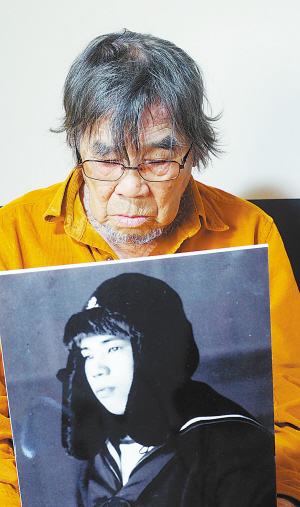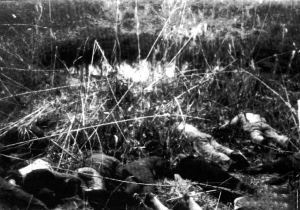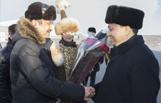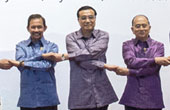95-year-old veteran of Japanese invader confesses
(english.jschina.com.cn) Updated: 2014-11-18 11:26"As an invader in the Japanese War of Aggression against China, I took part in the siege of Nanjing and feel ashamed about the Japanese army's atrocities to this day." That is how in an apartment in Osaka, Japan, 95-year-old former Japanese marine Mitani Sho began a conversation with a journalist from Xinhua Daily Press Group.
He described the Nanjing massacre he witnessed and confessed what the Japanese army had done. Talking angrily, the old man said the Abe administration has turned a blind eye to the history of the time and "wants to fight him".
The interview was conducted with the help of Ms Matsuoka Tamaki from Meishinkai. Two hours of talking revealed the life of Sho as a victim of war and somewhat inclined to introspection. The vicissitudes of history stamped on him cast light on the cruelty of past times and the grimness of reality. "The only reason I want to live to be 100 years old is to tell the truth," he said.
As a victimizer

Wearing gray, damaged, black-framed glasses and with curly hair, dressed in a loose yellow top, the tall, elderly man sat in a chair with a pile of black-and-white magnified photos at his feet that recorded different stages of his life in the army. Each time he wanted to reveal a truth, Sho picked up a photo with his wrinkled hands, stroking it while his fingers trembled when he felt stressful. The testimony, full of historical truth and reflections on human nature, appeared to be spoken to the journalist but in reality he seemed to be talking to himself as a young man fooled by militarism.
In the war - Four bamboo rafts loaded with the dead bodies of Chinese people floating down the river.
When the siege of Nanjing came to a terrible climax on Dec 12, 1937, the then 18-year-old Sho joined the battle with the Japanese fleet. He was the signaler on the newest destroyer Sea Wind and was in charge of delivering orders to fire weapons. He picked up a photo and said it was Sea Wind, part of the No 24 Japanese navy destroyer team. The other three warships in the destroyer team were named Mountain Wind, River Wind and River Breeze. They also took part in the offensive. An intensive hail of bullets destroyed Chinese resistance.
On December 13, the fleet anchored at Xiaguan. "I saw four bamboo rafts floating from the south that were littered with people. Being afraid of being attacked by soldiers in disguise, we shot for 10 minutes with no response," he recalled.
City Entering Ceremony - Zhongshan North Road Squares were piled with corpses.
Sho pulled out a photo of him in his winter navy uniform and continued his story. "On the night of December 16 we received an order to attend the city entering ceremony. Over the past two months after I joined the war, I hadn't set foot on land. To get off the ship for the ceremony was like going on an outing for me".
The dock was about 1 kilometer from Yijiang Gate. On the way, he witnessed damaged walls and burned houses. He was astonished to find a lot of scattered clothes and corpses on the street although Nanjing had been occupied for four days. He soon realized Nanjing was hell on earth. "About 50 to 60 corpses lay on the squares along Zhongshan North Road. Caked blood was everywhere. Many of the dead were elderly people, women and even children. They were civilians. Some corpses had their hands tied behind their backs. Some had been bayoneted, some shot; some were totally naked and some were beheaded. It was too horrible." Sho closed his eyes when recalling the event.
"Zhangshan North Road was not the only place like this. The whole of Nanjing city was hellish. The army was too shameless and went too far." Sho's hands held the photo tightly and couldn't stop trembling. "Dead silence enveloped the whole city. Even birdsong couldn't be heard. Apart from Japanese soldiers, two or three Chinese waving the Japanese national flag occasionally passed by. They would definitely have been killed had they not waved the Japanese national flag."

Sho put down the photo and fell into a long silence.
Yangtze Riverfront - Trucks of Chinese people are carried to the Yangtze riverfront and slaughtered.
On the second day after returning to the warship, Sho witnessed an even more awful scene. "On the afternoon of December 18 I was standing guard on the bridge. Suddenly, a machine-gun sounded. I looked at the dock and heard staccato shots. The warship was about 500 meters from the bank. I saw groups of Chinese people fall to the earth following the gunshots as I watched through a telescope. It was just like slow motion in a movie".
During the following days, he witnessed groups of Chinese people being taken to the riverfront and slaughtered from morning until nightfall. "Some trucks were loaded with 20 people, some with 30 people. Once they reached the riverfront, they were strafed to death by gunfire". Sho imitated the act of shooting.
Terrified cries mixed with the thunder of gunshots. It was only after many minutes that silence returned. But the noise echoed again soon. The massacre continued day after day. That time of year was the Yangtze River's dry season and the water level was dropping. "Piles of corpses embedded in the mud emerged. I saw Japanese soldiers force several Chinese people to collect the bodies. Some were buried. Some were thrown into the river. " He gesticulated. "This is the massacre I witnessed at Nanjing Zhangshan Dock. I left Nanjing on December 25. Every day before I left was like that".










